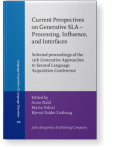Chapter 6
L2 acquisition of English flexible count and flexible mass nouns by L1-Japanese and L1-Spanish speakers
We examine the acquisition of the English count-mass distinction, in particular flexible nouns. Certain nouns are flexible in English as they can be either countable like a cake / cakes or mass such as cake. Our study is unique regarding the off-line and on-line tasks used and the L2 participant groups. We administered a quantity judgement task and a self-paced reading task to L1-Japanese and L1-Spanish speakers who judged four conditions – Count, Object, Substance and Flexible. The findings show that both L1-Japanese and L1-Spanish speakers performed differently on both tasks from the native speaker controls. We argue that the results of the self-paced reading task are inconsistent with the claims made by the Morphological Congruency Hypothesis (Jiang et al., 2011).
Article outline
- 1.Introduction
- 2.Count-mass nouns in English, Japanese, and Spanish
- 3.L2 acquisition studies of the English count-mass distinction
- 3.1L2 processing and the Morphological Congruency Hypothesis
- 4.The study
- 4.1Participants
- 4.2Quantity Judgement Task (QJT)
- 4.3Self-paced reading task
- 4.4Procedure
- 4.5QJT results
- 4.6SPRT Results
- 5.Discussion and summary
-
Acknowledgements
-
Notes
-
References
-
Appendix
This content is being prepared for publication; it may be subject to changes.
